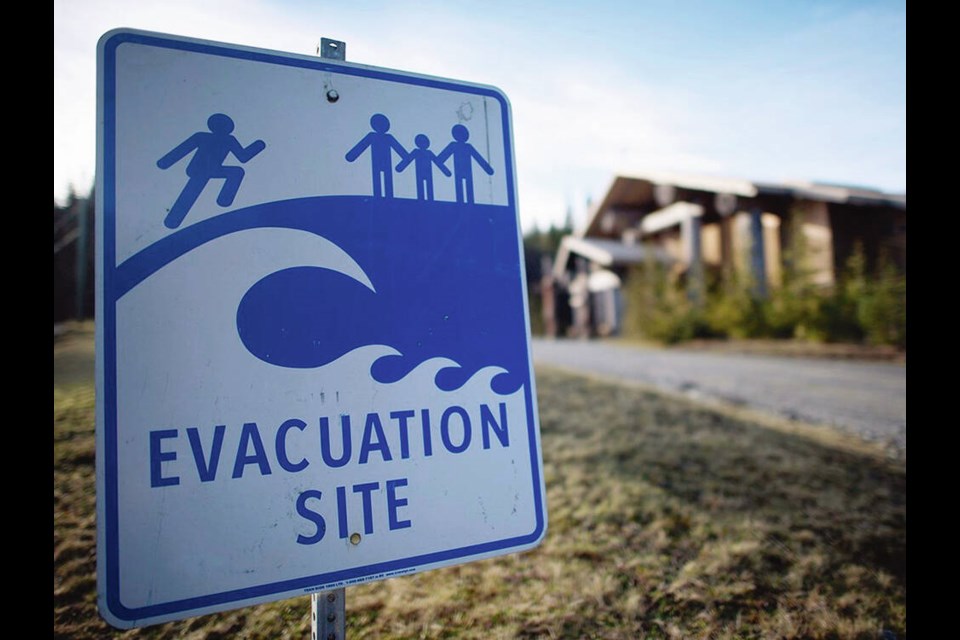It’s Tsunami Preparedness Week and you’ve probably heard the advice before: Pack an emergency kit, get familiar with the warning signs and know where to find high ground.
But if you have yet to do any of them, you’re not alone.
A study in the Victoria area that looked at who prepares for tsunamis — and why — found those who do tend to feel a strong sense of community, paired with being inclined to participate in community activities.
Those who don’t prepare lean on what Robert Gifford, a University of Victoria professor of psychology and environmental studies and co-author of the study, calls “dragons of inaction” — reasons people give to not do things they think they should.
Among the most common reasons were that preparing for a tsunami is too difficult, people don’t have the time, skills or knowledge required and there’s no need to because a serious tsunami is unlikely to occur during their lifetime.
“We assume that it won’t hit us or won’t hit us today, or we have other things to do,” Gifford said.
The study found that men, younger people, renters, singles and those without a religious affiliation tend to be less likely to prepare.
But recognizing the warning signs and knowing where to go can make a difference.
John Cassidy, an earthquake seismologist with Natural Resources sa���ʴ�ý, saw it for himself when he visited Chile after an 8.8-magnitude earthquake in 2010 that caused a massive tsunami.
“Everyone survived because they knew what to do. They knew where to go. They went to high ground. It was really remarkable,” Cassidy said. “Simple things really can make a huge difference.”
Warning signs that a tsunami may be coming include strong shaking that lasts more than 30 seconds, and water suddenly rushing into shore, or water quickly disappearing.
If you see any of these signs, head to higher ground immediately and stay put until authorities say it’s safe, as tsunamis come in a series of waves that can last hours, and the first waves may not be the biggest, Cassidy said.
Tsunamis can be triggered by anything that causes movement underwater, such as undersea volcanic eruptions and earthquakes near the coast that result in landslides into the ocean or a lake.
But the biggest tsunamis that could hit Vancouver Island would be generated by a subduction earthquake off the coast, said Cassidy.
Such earthquakes occur in cycles of about 250 to 800 years, with the last one 323 years ago, Cassidy said.
“We’re hundreds of years into the cycle, but we don’t know when one of those might happen, but they do happen and they have,” he said.
In 1700, a 9-magnitude earthquake off the coast generated a devastating tsunami. A 1964 quake created a tsunami that brought waves of six to seven metres in Port Alberni Inlet, two metres in Tofino and about a metre and a half in Victoria, Cassidy said.
The west coast of the Island is at greatest tsunami risk, with risk decreasing to the south in the Juan de Fuca Strait and lowest in the Strait of Georgia, he said.
Many coastal communities, including several on the Island, are hosting high-ground hikes this week, inviting residents to gather in a tsunami hazard area and practise going to a safe place.
In Sooke, residents are invited to join a walk starting from Whiffin Spit on Thursday at 11 a.m. Colwood residents are encouraged to head to the waterfront or the Royal Roads shoreline on their own to follow tsunami signs showing the way to higher ground.
Some municipalities are also offering preparedness workshops. The District of Saanich is putting on a presentation for residents to learn how to prepare to sustain themselves for at least seven days following a disaster.
A one-hour in-person presentation is set for Thursday at Cedar Hill Recreation Centre at 7 p.m. and online on April 24 at 7 p.m.
The City of Victoria offers similar workshops and includes a recording of an emergency preparedness training session on its website at .
More information on how to prepare for a tsunami is available at . The site includes an interactive map to check for areas that are at high risk of a tsunami and to find a safe travel route in the event of a tsunami.
>>> To comment on this article, write a letter to the editor: [email protected]



